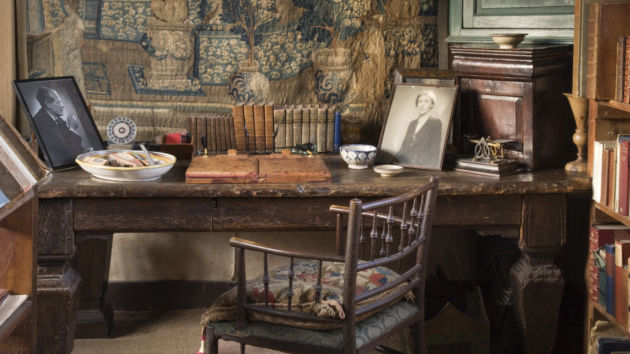In 1994, Adrienne Rich stated that lesbianism was ‘not even written out of history – as it was barely even written in’ (Rich, 1994, p.17). In order to write queer women into history and challenge the continued erasure and censorship of queer communities, we have to understand the way sexuality and labels have shifted with time. This includes interrogating binary views of sexual identities and defying the need for simple categorization. The love letters exchanged between Vita Sackville-West and Virginia Woolf are the perfect example of queer love which defies labels. The relationship between the two writers remains one of the most hotly debated within queer and feminist scholarship (Berman, 2016). While Woolf has attracted more research and interest from academics, I have become fascinated by Sackville-West, a poet, writer and passionate gardener who had an open relationship with her husband, dated multiple women over the course of her life, and cross-dressed in the streets of Paris.
My first introduction to her work was through her tender diary entries and letters in the book Love Letters: Virginia Woolf and Vita Sackville-West. This intimate collection traces the relationship of the two women over 20 years, ending only with Woolf’s suicide in 1941. I was struck by the slow romance, and ultimately friendship, that the two curated throughout their years of correspondence. In one letter, Vita wrote:
“I am reduced to a thing that wants Virginia. I composed a beautiful letter to you in the sleepless nightmare hours of the night, and it has all gone. I just miss you, in a quite simple desperate human way…”
Vita Sackville-West was born in 1892 into the aristocracy of Victorian England. Over the course of her life, she became well-known for both her best-selling books and her scandalous affairs with women. Vita was married to Harold Nicolson, who himself had multiple relationships with men throughout their unconventional open marriage.
After Sackville-West died in 1962, her son Nigel found 70 pages of a memoir hidden in her desk. In it, she “confessed” to her sexuality and detailed the different relationships with women she had throughout her life. It is a remarkable piece of history – however, it wasn't until 1972 that the memoir was published in the form of a book named Portrait of a Marriage written by Nigel. To this day, the only way to access this confession is through the book, which is filled with Nigel’s own heteronormative ideas and commentary about his mother.
In 1885, seven years before Vita Sackville-West’s birth, the Criminal Law Amendment Act was drafted to criminalise male homosexuality. Echoing ideas that would continue to permeate contemporary views of women’s sexuality, it is said that when asked whether female homosexuality should be included in the Bill, Queen Victoria disagreed on the basis that women being with each other was impossible. After all, she asked the court – what could two women possibly do with one another?
Sackville-West and Woolf lived through two different time periods – the Victorian era and the early twentieth century. The Church was at the peak of its power as an institution in a strongly patriarchal society. The doctrine of female innocence meant that women were thought to have no sexual desires or awareness of sex, and were essentially forbidden knowledge of their own bodies. However, the first wave of Feminism was beginning to take place, and the idea of gender equality was beginning to spread throughout England. The study and value of science meant that there was a rise in gender, psychology, and sex studies. When looking at extracts of Sackville-West’s diary, these shifting ideologies are present in her own inner turmoil and anxieties about her sexuality and gender.
“Violet [one of Vita’s lovers] told him she had meant to run away with me instead of marrying him; she told him she didn’t care for him. He got very white, and I thought he was going to faint… I wanted to say ‘Don’t you know, you stupid fool, that she is mine in every sense of the word?’ but I was afraid that he would kill her if I did… If I had been a man I would have married her in an instant.”
Unfortunately, like many queer people of the time, Sackville-West was never given the luxury of choice when it came to marriage. Crushingly, she also wrote about how she wished she had never discovered her queer sexuality. Consistently referencing her lost “innocence”, Sackville-West referred to her sexuality as “deviant” and “unnatural”.
“A mad and irresponsible summer of moonlight nights and infinite escapades… Things were not tragic for us then, because although we cared passionately we didn’t care deeply – not like now… no, things weren’t tragic, they were new and one side of my life was opened up to me… Of course I wish now that I had never made these discoveries. One doesn’t miss what one doesn’t know, and now life is made wretched… I often long for ignorance and innocence.”
Sexism and homophobia intersect for queer women in a way which amplifies the erasure of their identities. There is no doubt that the homophobia and stigma surrounding Vita’s homosexuality influenced her son Nigel’s decision to keep the manuscript of her diary secret until the 1970’s. A key concern around the publication of this diary is the ethics of Nigel’s writing. Vita did write that she wished for her memoir to be published, and as such the privacy of her confession is not under question. However, Nigel’s strong authorial voice and extensive editing rewrites the narrative surrounding Vita’s queer relationships. Nigel uses his position of power as an editor to frame the women Vita had affairs with as evil and malicious, while positioning his father and her other male lovers as her saviours. In doing this, Vita is ‘redeemed’ from her lesbian desire and her confession is overwritten, imposing a narrative of heteronormativity.
Vita Sackville-West was a rich, white woman from a well-educated English background. We know little about queer women in history, but most of what we do know is from women like her who had the privilege to be able to recount their experiences. Women of colour and those living poverty were not afforded the power that money gave to those like Sackville-West. Her position allowed her to avoid any serious repercussions and her money meant she had bargaining power in her marriage. Her experience is not representative of all queer women of the time, and we should take care not to homogenise them. Intersecting axes of oppression such as racism and classism remain barriers to historians searching for first hand diary and journals of diverse queer lives.
“I hold the conviction that as centuries go on… that connections such as mine will to a very large extent cease to be regarded as merely unnatural and will be understood far better, at least in their intellectual if not in their physical aspect… I believe it will be recognized that many more people of my type do exist.”
While the relationships of queer women throughout history are now widely accepted as fact, many early twentieth-century academics actively contributed to the historical denial and dismissal of queer women’s existences (Kaivola, 1998). It was feminist scholars in the 60s and 70s who endeavoured to reconnect queer women’s identities – and subsequently, queerness – with their writing (Barrett, 1997). There still remains a significant amount of work to be done in ‘queering’ history, in particular outside of western notions of sexuality and identity.
Just like language as a whole, gender and sexuality labels have shifted and evolved through time. The term ‘lesbian’ has been contested and often used flexibly when retrospectively assigning historical figures labels. Some argue that it isn’t necessary for those such as Sackville-West and Woolf to identify with contemporary notions of identity in order for us to label them (Cramer, 1992). But as others point out, there are inherent difficulties in ‘claiming sexual identities for women who did not think of themselves as lesbian or who could not have understood their identities in the late 20th-century’ (Kaivola, 1998, p. 19).
Personally, I believe that labels are not always useful or even necessary in reclaiming queer history. Perhaps we must make peace with leaving such questions uncertain, and ‘‘...holding open the question of sexuality rather than dismissing it by way of stable conclusions” (Sprole, 2006, p. 11). While it is clearly necessary to acknowledge and revive queer figures of history, we can do this without the specificity of labels. As uncomfortable and unsatisfying as this uncertainty might make us, it is crucial in order to contest an essentialist vision of sexuality.
Reading the nicknames, anxieties, memories and fights between Vita Sackville-West and Virginia Woolf makes their body of literature all the more endearing. In particular, Woolf’s scandalously experimental novel, Orlando, a playful gender-bending biography inspired by Sackville-West, becomes charged with meaning. In their letters, Sackville-West frequently signed off with ‘Your Orlando’. When news that Woolf had passed away reached Sackville-West, she wrote in her diary:
“I still think that I might have saved her if only I had been there and had known the state of mind she was getting into.”
When Sackville-West died of cancer in 1962, her desk was preserved as she left it, with two framed pictures: one of her husband, Harold, and one of Virginia.
Image: Vita Sackville-West's desk remains untouched at and can be visited at Sissington Castle, England (National Trust Images: John Hammond)

References
Barrett, E., & Cramer, P. (Eds.). (1997). Virginia Woolf: lesbian readings. NYU Press.
Bell, Q. (1972). Virginia Woolf: A Biography. New York: HBJ.
Berman, J. (Ed.). (2016). A Companion to Virginia Woolf. John Wiley & Sons.
Bethel, L. (1982). 'This Infinity of Conscious Pain': Zora Neale Hurston and the Black Female Literary Tradition. All the women are white, all the blacks are men, but some of us are brave, 176-188.
Castle, T. (1993). The Apparitional Lesbian: Female Homosexuality and Modern Culture. New York: Columbia UP.
Cramer, P. (1992). "Notes from Underground: Lesbian Ritual in the Writings of Virginia Woolf." Virginia Woolf Miscellanies. Proceedings of the First Annual Conference on Virginia Woolf. Ed. Mark Hussey and Vara Neverow-Turk. New York: Pace UP, 1.
Gordon, L. (1984). Virginia Woolf: A Writer's Life. New York: Norton.
Kaivola, K. (1998). Virginia Woolf, Vita Sackville-West, and the Question of Sexual Identity. Woolf Studies Annual, 4, 18-40.
Newton, E. (1984). "The Mythic Mannish Lesbian: Radclyffe Hall and the New Woman." Signs 9(4), 557-75.
Nicolson, N. (1990). Portrait of a Marriage: V. Sackville-We Nicolson. 1973. New York: Atheneum.
Rich, A. C. (2003). Compulsory heterosexuality and lesbian existence (1980). Journal of Women's History, 15(3), 11-48.
Sproles, K. Z. (2006). Desiring Women: The Partnership of Virginia Woolf and Vita Sackville-West. University of Toronto Press.


 -
-